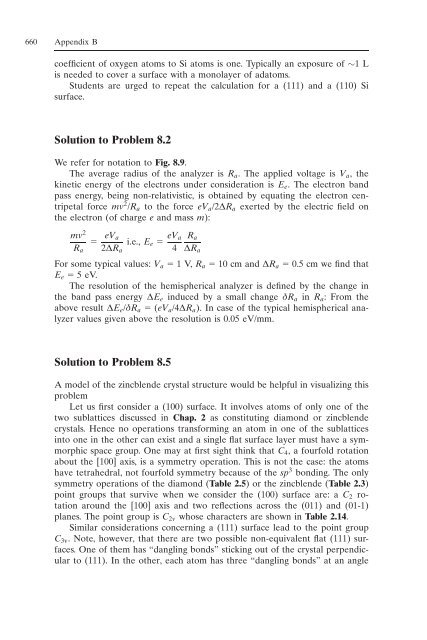10. Appendix
Create successful ePaper yourself
Turn your PDF publications into a flip-book with our unique Google optimized e-Paper software.
660 <strong>Appendix</strong> B<br />
coefficient of oxygen atoms to Si atoms is one. Typically an exposure of ∼1 L<br />
is needed to cover a surface with a monolayer of adatoms.<br />
Students are urged to repeat the calculation for a (111) and a (110) Si<br />
surface.<br />
Solution to Problem 8.2<br />
We refer for notation to Fig. 8.9.<br />
The average radius of the analyzer is Ra. The applied voltage is Va, the<br />
kinetic energy of the electrons under consideration is Ee. The electron band<br />
pass energy, being non-relativistic, is obtained by equating the electron centripetal<br />
force mv 2 /Ra to the force eVa/2¢Ra exerted by the electric field on<br />
the electron (of charge e and mass m):<br />
mv 2<br />
Ra<br />
eVa<br />
2¢Ra<br />
i.e., Ee eVa<br />
4<br />
Ra<br />
¢Ra<br />
For some typical values: Va 1V,Ra 10 cm and ¢Ra 0.5 cm we find that<br />
Ee 5eV.<br />
The resolution of the hemispherical analyzer is defined by the change in<br />
the band pass energy ¢Ee induced by a small change ‰Ra in Ra: From the<br />
above result ¢Ee/‰Ra (eVa/4¢Ra). In case of the typical hemispherical analyzer<br />
values given above the resolution is 0.05 eV/mm.<br />
Solution to Problem 8.5<br />
A model of the zincblende crystal structure would be helpful in visualizing this<br />
problem<br />
Let us first consider a (100) surface. It involves atoms of only one of the<br />
two sublattices discussed in Chap. 2 as constituting diamond or zincblende<br />
crystals. Hence no operations transforming an atom in one of the sublattices<br />
into one in the other can exist and a single flat surface layer must have a symmorphic<br />
space group. One may at first sight think that C4, a fourfold rotation<br />
about the [100] axis, is a symmetry operation. This is not the case: the atoms<br />
have tetrahedral, not fourfold symmetry because of the sp 3 bonding. The only<br />
symmetry operations of the diamond (Table 2.5) or the zincblende (Table 2.3)<br />
point groups that survive when we consider the (100) surface are: a C2 rotation<br />
around the [100] axis and two reflections across the (011) and (01-1)<br />
planes. The point group is C2v whose characters are shown in Table 2.14.<br />
Similar considerations concerning a (111) surface lead to the point group<br />
C3v. Note, however, that there are two possible non-equivalent flat (111) surfaces.<br />
One of them has “dangling bonds” sticking out of the crystal perpendicular<br />
to (111). In the other, each atom has three “dangling bonds” at an angle










